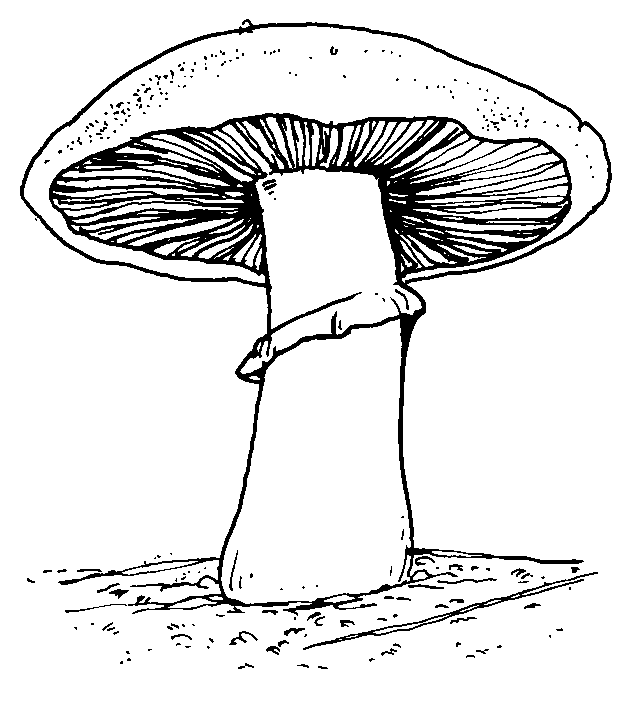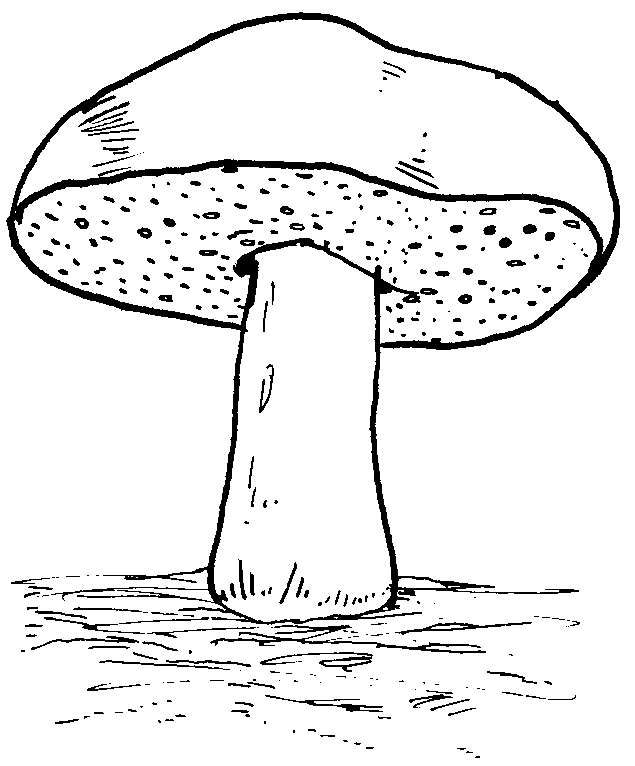| << Chapter < Page | Chapter >> Page > |
 |
| Figure 1 Threads of mucor or mould on bread |
 |
| Figure 2 Mushroom with spore-bearing gills below the cap |
 |
| Figure 3 The Botelus, another edible fungus |
When you examine fungi under a microscope, you will see many threads growing in all directions, almost like an untidy cobweb. Each thread is branched, like a tree, and each branch has a further range of branches. Small round knobs are visible at the ends of some branches. These little knobs are containers, because they actually are hollow and are full of small seeds. These are called spores. They are so very small that a thousand of them will fit onto the head of a pin. Fungi are different from other plants in that they do not need light for regeneration, but they do need air, food and water. People do not need to plant the seeds of fungi as spores will simply begin growing wherever there is food, air and moisture, for instance on a damp towel. The skin of fruit is also always infested with spores, but they will not develop while the fruit is kept dry.

Assignment 16
Cultivating Bread Mould
You will be cultivating fungi now. Take two slices of white bread. Break them in half. Wipe each piece of bread along the floor or across a windowsill to pick up some spores. Now sprinkle water on the bread, but take care not to wet it too much or the bread will break. Place each piece of bread in an airtight container, and screw on the lid. Place the containers in a warm, dark cupboard. The spores will have all that they need, namely food (the bread), water and the air that is trapped in the container. Warmth is not necessary, but will encourage faster growth of the spores. Take the containers out of the cupboard after three days and examine them to answer the following questions:
| CONTROL | YES | NO |
| Did I execute the experiment with care? | ______ | ______ |
| Was my experiment successful? | ______ | ______ |
| Did a downy, white growth develop on the bread? | ______ | ______ |
| Did black spores like grains of pepper occur in the bread mould? | ______ | ______ |
| Give a possible reason, if necessary, for the lack of success of the experiment: ____________________________________________________________________ ____________________________________________________________________ ____________________________________________________________________ ____________________________________________________________________ ____________________________________________________________________ ____________________________________________________________________ |
(ii) Usefulness for people
Except for the fact that people use some fungi as food, fungi are also used as medication. A fungus that has become a wonderful friend to people, namely Penicillium, kills harmful bacteria in the human body.

Assignment 17
Do some research to find out how the yeast fungus manages to make wine. Write two paragraphs on how this fungus operates and on other useful ways of using the fungus.
_____________________________________________________________________
_____________________________________________________________________
_____________________________________________________________________
_____________________________________________________________________
_____________________________________________________________________
_____________________________________________________________________
_____________________________________________________________________
_____________________________________________________________________
_____________________________________________________________________
_____________________________________________________________________
_____________________________________________________________________
_____________________________________________________________________
The food chain therefore is an endless process.
Food is the medium through which materials, to construct body tissues, are acquired. In this way energy for life is passed on along the chain!

Learning Outcome 1: The learner will be able to act confidently on curiosity about natural phenomena, and to investigate relationships and solve problems in scientific, technological and environmental contexts.
Assessment Standard 1.2: We know this when the learner We know this when the learner leads investigations and gathers data.
Learning Outcome 2: The learner will know and be able to interpret and apply scientific, technological and environmental knowledge.
Assessment Standard 2.3: We know this when the learner interprets information.

Notification Switch
Would you like to follow the 'Natural sciences grade 6' conversation and receive update notifications?